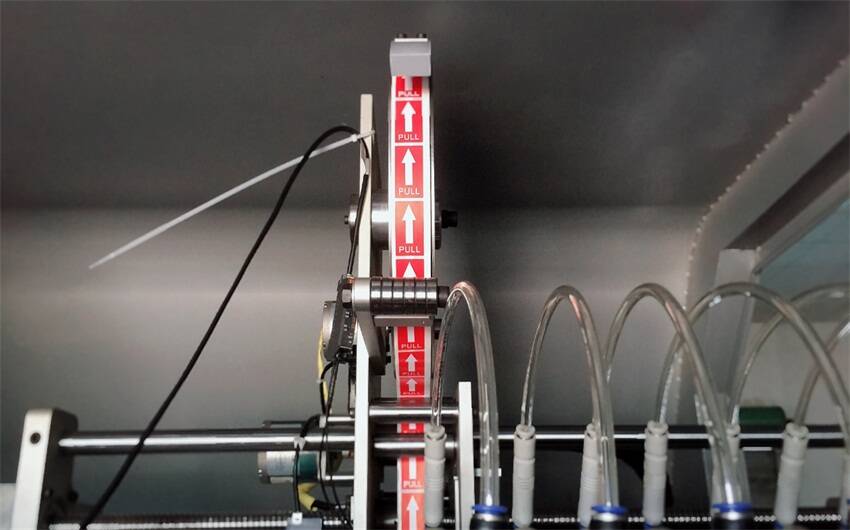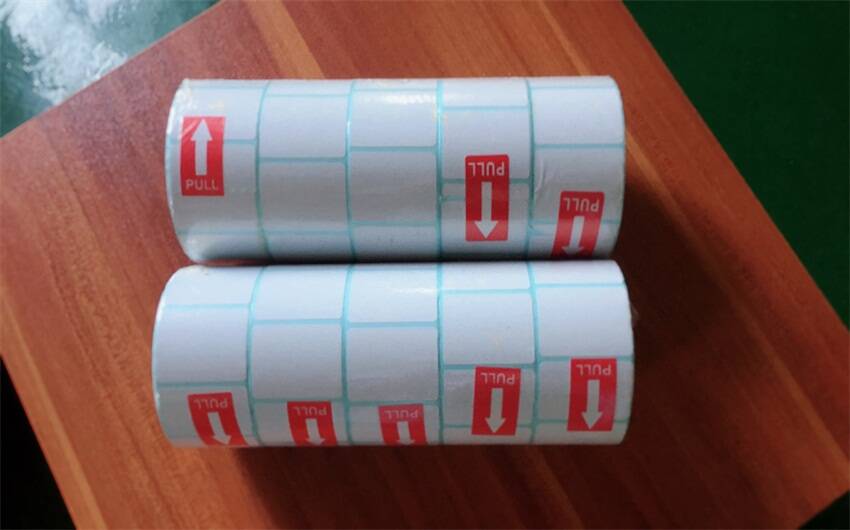Zhuhai Zhongya Technology Co., Ltd.
Full-Auto Slitting Machine Manufacturer in China Since 2009
Zhuhai Zhongya Technology Co., Ltd.
Full-Auto Slitting Machine Manufacturer in China Since 2009
Self-adhesive label, also called self-adhesive label material, is a composite material with paper, film or other special materials as the fabric, adhesive on the back, and silicon-coated protective paper as the backing paper. And after printing and die cutting, it becomes a finished label.
Self-adhesive materials are usually printed and processed on the label linkage. The most common printing form is embossing, and other printing methods are also used. Common faults in the printing stage are:

Fault 1: The ink layer on the surface of the label does not dry after printing, it dries slowly or the ink layer is wiped off.
Reason: The printing ink layer is too thick, the amount of ink is too large, the additives used in the ink are not suitable, the ink is denatured or the type of ink used is not suitable, will cause the ink layer of the label to not dry, dry slowly or wipe the ink layer after printing. Just drop; besides, the machine runs too fast and dry...
The solution is:
1. Use deep ink thin printing to reduce the thickness of the ink layer;
2. Use special inks that dry quickly;
3. Use matching additives and add matching desiccants;
4. Take measures, Extend the drying or curing time of the printed matter;
5. Increase the room temperature and properly exhaust air to speed up the ink drying speed.
Fault 2: The ink layer on the film surface has poor adhesion fastness and easy to drop ink.
If the film surface is not corona treated, or the surface tension of the film is lower than the surface tension of the ink, the ink will not adhere easily; the characteristics of the unused ink and film Such failures can also occur when they do not match or use special inks, and such failures inevitably occur when using expired or invalid inks. In addition, the power of the drying device (UV or infrared hot air drying) is low, so that the ink cannot be completely dried or the printing ink layer is too thick, the amount of ink is too large, and the ink viscosity is too large. The ink will become brittle after drying for a long time, which will also cause the film The surface printing ink layer has poor adhesion and easy ink drop.
The solution is:
1. To increase the surface tension of the printing material, the surface tension value must be above 38 dyne/cm;
2. The rotary label machine should be equipped with a corona device, and the surface tension of the film can be increased by random corona;
3. Can be used first Transparent solvent-based inks are pre-ordered to increase the surface tension of the printing materials;
4.Use special inks and supporting additives that match the printing materials;
5.Increase the drying or curing power, or reduce the machine speed, and increase the drying time ;
6.Printing ink to be as thin as possible, to minimize the amount of ink, overprint several times if necessary can be monochrome;
7.The recommended printing UV coating to protect the printed ink layer, the ink layer increases adhesion fastness.
Fault 3: The inks printed on FASCLEAR and PRIMAX have poor adhesion fastness
Reason: FASCLEAR and PRIMAX materials are soft matt surface, the surface strength is poor, scratches will appear when lightly scratched with a nail, no matter the surface tension is high or low, the problem of poor ink adhesion will occur, and even It is the ink that does not have adhesion fastness problems on other printing materials, and the problem of poor ink adhesion fastness when printed on FASCLEAR and PRIMAX materials. The so-called ink drop here actually means that the surface of the printing material is damaged and has nothing to do with the ink.
The solution is:
Add a hardener to the ink and varnish, or buy ink with a hardener to improve the adhesion fastness of the ink to FASCLEAR and PRIMAX materials by increasing the friction resistance and hardness of the ink and varnish .
Fault 4: After the end of the roll is fragile, the paper cannot be unrolled and printed
Reason: When slitting and rewinding small rolls, the rewinding tension is too large, resulting in too tight rewinding, which will cause this failure; too high temperature in the storage or printing workshop can also cause this failure; and squeezing or storage time is too long. One of the reasons for this failure.
The solution is:
1. In addition to improving the corresponding storage and processing conditions for the above reasons, alcohol can also be used to wipe the end surface of the permeable glue to dilute the adhesive and reduce its viscosity to facilitate unwinding;
2. Unroll gently, put powder on both ends and rewind slowly;
3. The improved roll of self-adhesive material should be slowly printed and die-cut on the intermittently fed label machine
Fault 5: Partial ink drop on the surface of the film after printing-the ink adhesion fastness is inconsistent
Reason: First, when multi-color overprinting, the bottom ink is not completely dried and is covered by the surface ink; second, the ink of the same color exposed to the outside has been completely dried due to the thick ink layer, but the ink underneath is still not available Dry; Third, the UV curing function of the monochrome group;
The solution is:
1. Reduce the thickness of the ink layer;
2. Increase the curing power of the VU drying device;
3. Reduce the speed of the machine and increase the curing time of the ink. Monochrome multi-station curing can be used;
4. In the process design, it is necessary to avoid ink stack printing as much as possible, and the process of parallel printing with the edge of the figure rising color can be adopted;
5. Increase the power of the corona treatment device, increase the surface tension of the printing material, and make the ink easier to dry and adhere, thereby increasing the adhesion fastness of the ink;
6. Use ink with fast curing speed or add photosensitizer (desiccant) in the ink.

Fault 6: Fisheye on the surface of the ink layer on the spot
Reason: Fish eyes are caused by paper wool, paper scraps or dust. The appearance of fish eyes is not only related to the cleanliness of the environment and the sealing condition of the workshop, but also to static electricity, because static electricity will attract impurities such as dust and paper scraps to the surface of the printing material; the appearance of fish eyes is also related to the quality of the printing material itself and its magnetic density. Printing materials with uneven, low coating firmness, short fibers and low firmness are prone to fisheye problems; in addition, printing materials with poor cutting quality and low cutting precision are also prone to fisheye problems.
The solution is:
1. Improve and purify the production environment, and qualified printing manufacturers should conduct sealing management on the printing press;
2. Install static eliminator and printing material cleaner on the printing machine to prevent dust and paper scraps from being left on the printing material surface;
3. Choose high-quality printing materials, and require the surface coating to have strong firmness and not easy to glue off;
4. Improve the slitting quality of the roll material to prevent debris from being generated on the end surface or around the material;
5. Regularly clean the printing plate and the inking system of the printing press;
Fault 7: Paper materials fall off
Reason: The paper itself is of poor quality, and the surface coating is low in firmness, and it is easy to drop powder; the environment is humid or the material itself causes the surface strength of the printing material coating to decrease or the ink viscosity is too large, which can easily cause the powder drop failure; in addition, the powder drop is also It is related to the press side of the label.
The solution is:
1. Use high-quality printing materials, especially when printing on a large area;
2. To reduce the viscosity of the ink, the viscosity of the printing ink used in each color sequence is required to decrease sequentially;
3. Improve the storage environment and printing environment of materials and reduce the environmental humidity;
4. Change solid printing to flat screen printing in process design;
5. Before formal printing, take empty paper for pre-printing, and some floating powder can be removed;
6. Change the printing method of printing equipment to reduce the printing contact area.
Fault 8: Inaccurate overprinting of single printing
Reason: Inaccurate overprinting caused by unstable paper size.
The paper size changes due to the different humidity in the printing and processing environment of the paper and composite manufacturing; uneven moisture content on the surface of the paper causes deformation or local deformation of the four sides of the paper; in the same size paper, due to the inconsistent fiber direction of some papers, The shrinkage rate is different; and the instability of the temperature and humidity in the workshop will cause a large change in paper size.
The solution is:
1. Gradually control the printing workshop at 20-22 degrees Celsius and the relative humidity at 50%.
2. Control the dampening solution to the lowest level to reduce the swelling and deformation of the paper;
3. Try to use a multi-color printing machine to complete multi-color printing at one time;
4. It is necessary to protect the semi-finished product for multiple printing with a single color machine, and it is best to seal it with a plastic sheet, especially in the rainy season;
5. Use paper with the same fiber direction. Paper with different fiber directions should be stacked and printed separately;
6. When conditions permit, the paper should enter the printing workshop in advance to allow sufficient time to balance with the ambient temperature and humidity.
7. For paper with excessive humidity, pre-empty printing can be used to speed up the temperature and humidity balance with the environment;
8. For small labels that need hot stamping and die cutting, they should be printed first. After the size is stable, the hot stamping plate and die-cutting plate will be made according to the actual size.
Copyright 2019 Zhuhai Zhongya Packaging Equipment Co.,Ltd. All Right Reserved.
We are here to help you! If you close the chatbox, you will automatically receive a responsefrom us via email. Please be sure to leave yourcontact details so that we can better assist